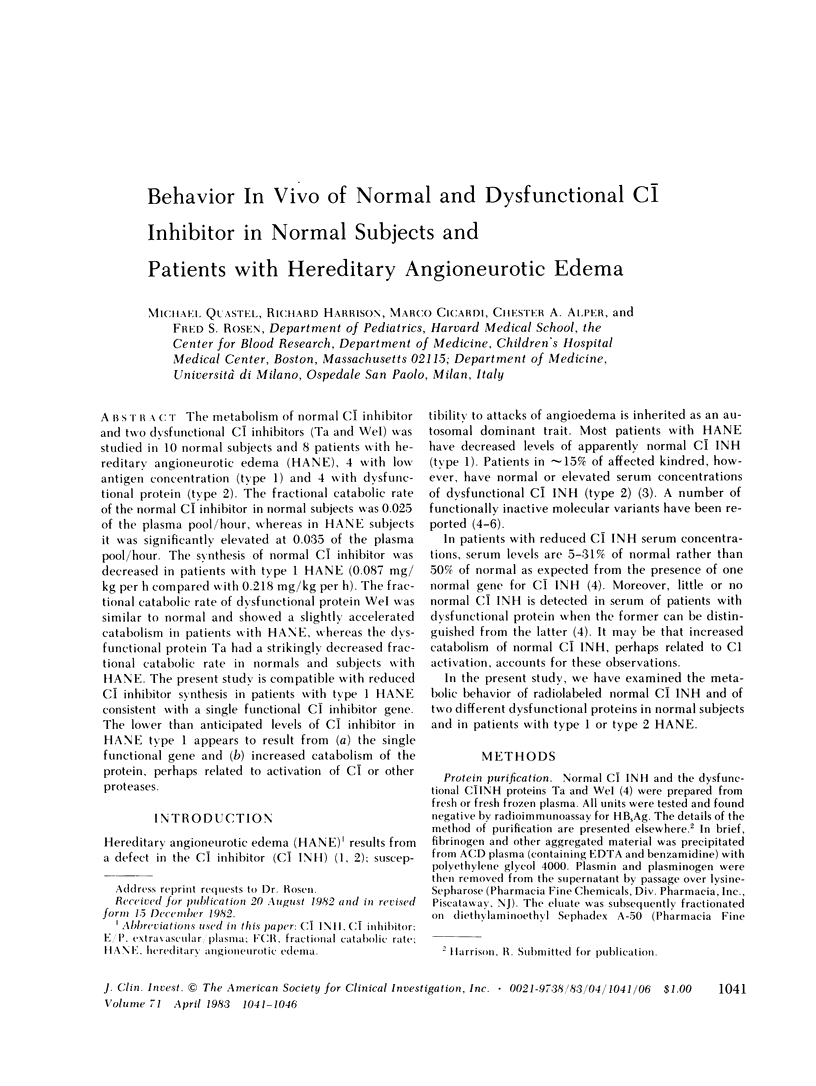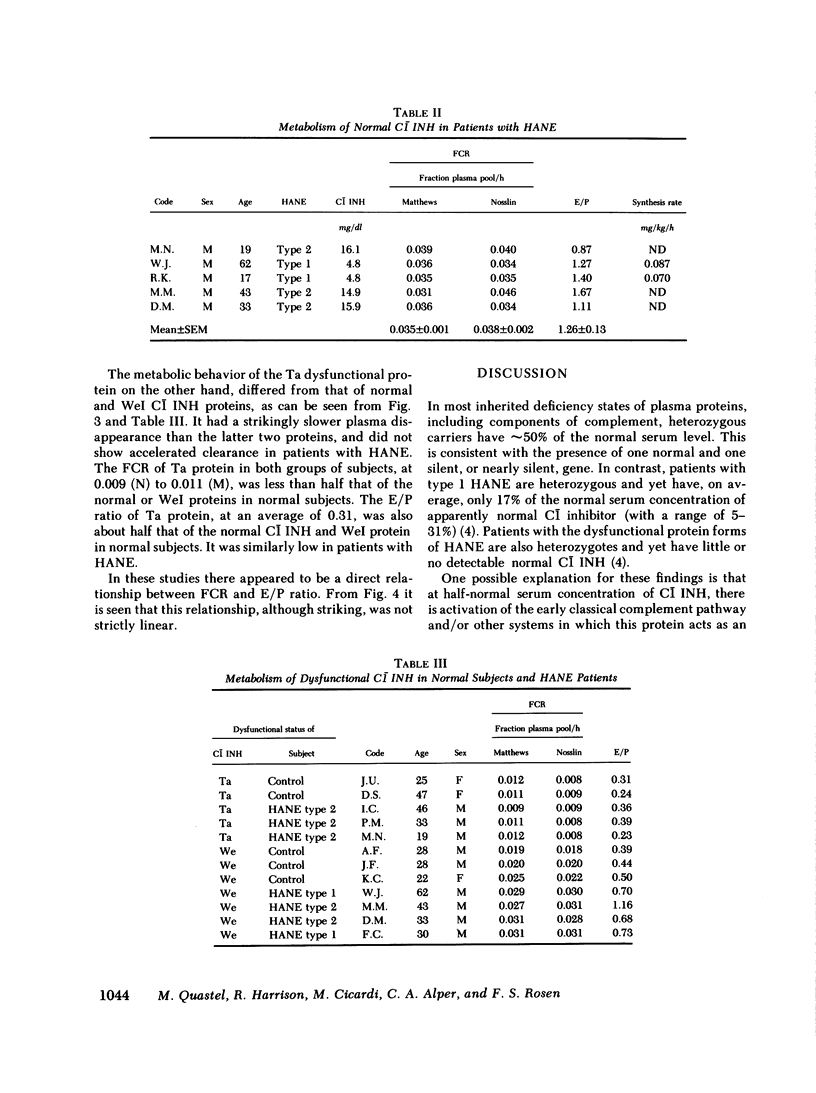Abstract
The metabolism of normal C1 inhibitor and two dysfunctional C1 inhibitors (Ta and WeI) was studied in 10 normal subjects and 8 patients with hereditary angioneurotic edema (HANE), 4 with low antigen concentration (type 1) and 4 with dysfunctional protein (type 2). The fractional catabolic rate of the normal C1 inhibitor in normal subjects was 0.025 of the plasma pool/hour, whereas in HANE subjects it was significantly elevated at 0.035 of the plasma pool/hour. The synthesis of normal C1 inhibitor was decreased in patients with type 1 HANE (0.087 mg/ kg per h compared with 0.218 mg/kg per h). The fractional catabolic rate of dysfunctional protein WeI was similar to normal and showed a slightly accelerated catabolism in patients with HANE, whereas the dysfunctional protein Ta had a strikingly decreased fractional catabolic rate in normals and subjects with HANE. The present study is compatible with reduced C1 inhibitor synthesis in patients with type 1 HANE consistent with a single functional C1 inhibitor gene. The lower than anticipated levels of C1 inhibitor in HANE type 1 appears to result from (a) the single functional gene and (b) increased catabolism of the protein, perhaps related to activation of C1 or other proteases.
Full text
PDF





Images in this article
Selected References
These references are in PubMed. This may not be the complete list of references from this article.
- ALPER C. A., FREEMAN T., WALDENSTROEM J. THE METABOLISM OF GAMMA GLOBULINS IN MYELOMA AND ALLIED CONDITIONS. J Clin Invest. 1963 Dec;42:1858–1868. doi: 10.1172/JCI104870. [DOI] [PMC free article] [PubMed] [Google Scholar]
- Alper C. A., Rosen F. S. Alper CA, Rosen FS: Studies of the in vivo behavior of human C'3 in normal subjects and patients. J Clin Invest. 1967 Dec;46(12):2021–2034. doi: 10.1172/JCI105691. [DOI] [PMC free article] [PubMed] [Google Scholar]
- Brackertz D., Isler E., Kueppers F. Half-life of C1INH in hereditary angioneurotic oedema (HAE). Clin Allergy. 1975 Mar;5(1):89–94. doi: 10.1111/j.1365-2222.1975.tb01839.x. [DOI] [PubMed] [Google Scholar]
- DONALDSON V. H., EVANS R. R. A BIOCHEMICAL ABNORMALITY IN HEREDIATRY ANGIONEUROTIC EDEMA: ABSENCE OF SERUM INHIBITOR OF C' 1-ESTERASE. Am J Med. 1963 Jul;35:37–44. doi: 10.1016/0002-9343(63)90162-1. [DOI] [PubMed] [Google Scholar]
- Gigli I., Ruddy S., Austen K. F. The stoichiometric measurement of the serum inhibition of the first component of complement by the inhibition of immune hemolysis. J Immunol. 1968 Jun;100(6):1154–1164. [PubMed] [Google Scholar]
- Harpel P. C., Cooper N. R. Studies on human plasma C1 inactivator-enzyme interactions. I. Mechanisms of interaction with C1s, plasmin, and trypsin. J Clin Invest. 1975 Mar;55(3):593–604. doi: 10.1172/JCI107967. [DOI] [PMC free article] [PubMed] [Google Scholar]
- Harpel P. C., Hugli T. E., Cooper N. R. Studies on human plasma C1 inactivator-enzyme interactions. II. Structural features of an abnormal C1 inactivator from a kindred with hereditary angioneurotic edema. J Clin Invest. 1975 Mar;55(3):605–611. doi: 10.1172/JCI107968. [DOI] [PMC free article] [PubMed] [Google Scholar]
- LANDERMAN N. S., WEBSTER M. E., BECKER E. L., RATCLIFFE H. E. Hereditary angioneurotic edema. II. Deficiency of inhibitor for serum globulin permeability factor and/or plasma kallikrein. J Allergy. 1962 Jul-Aug;33:330–341. doi: 10.1016/0021-8707(62)90032-1. [DOI] [PubMed] [Google Scholar]
- Laurell A. B., Lindegren J., Malmros I., Mårtensson H. Enzymatic and immunochemical estimation of C'1 esterase inhibitor in sera from patients with hereditary angioneurotic edema. Scand J Clin Lab Invest. 1969 Oct;24(3):221–225. doi: 10.3109/00365516909080156. [DOI] [PubMed] [Google Scholar]
- Laurell C. B. Quantitative estimation of proteins by electrophoresis in agarose gel containing antibodies. Anal Biochem. 1966 Apr;15(1):45–52. doi: 10.1016/0003-2697(66)90246-6. [DOI] [PubMed] [Google Scholar]
- MATTHEWS C. M. The theory of tracer experiments with 131I-labelled plasma proteins. Phys Med Biol. 1957 Jul;2(1):36–53. doi: 10.1088/0031-9155/2/1/305. [DOI] [PubMed] [Google Scholar]
- Nosslin B. Analysis of disappearance time-curves after single injection of labelled proteins. Ciba Found Symp. 1972;9:113–130. doi: 10.1002/9780470719923.ch7. [DOI] [PubMed] [Google Scholar]
- ROSEN F. S., PENSKY J., DONALDSON V., CHARACHE P. HEREDITARY ANGIONEUROTIC EDEMA: TWO GENETIC VARIANTS. Science. 1965 May 14;148(3672):957–958. doi: 10.1126/science.148.3672.957. [DOI] [PubMed] [Google Scholar]
- Rosen F. S., Alper C. A., Pensky J., Klemperer M. R., Donaldson V. H. Genetically determined heterogeneity of the C1 esterase inhibitor in patients with hereditary angioneurotic edema. J Clin Invest. 1971 Oct;50(10):2143–2149. doi: 10.1172/JCI106708. [DOI] [PMC free article] [PubMed] [Google Scholar]
- Ziegler J. B., Rosen F. S., Alper C. A., Grupe W., Lepow I. H. Metabolism of properdin in normal subjects and patients with renal disease. J Clin Invest. 1975 Sep;56(3):761–767. doi: 10.1172/JCI108147. [DOI] [PMC free article] [PubMed] [Google Scholar]




